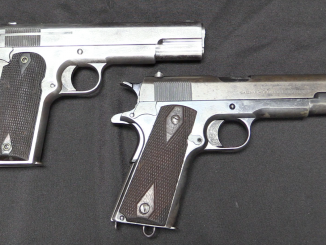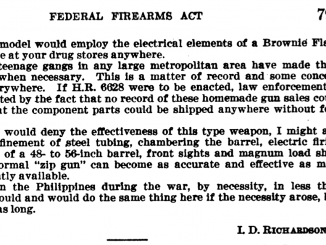The final production version of the Hall was Simeon North’s Model 1843 Carbine, of which 10,500 were made between 1844 and 1853. It used North’s percussion update to the design, and a cleverly simple calming lug connected to a lever on the right side of the action to open the breech. These were smoothbore .54 caliber guns, issued to the Dragoons and used in the Mexican-American War.
Related Articles

Prototype
A Few Last Changes Before Perfection: The Colt Models 1909 & 1910
These are lots #1477 (Model 1909) and #1475 (Model 1910) in the upcoming RIA Premier Auction. It was scheduled for April, but has been postponed – check their web site for upcoming Online Only auctions […]

Gunsmithing
Richardson Guerrilla Gun in Congressional Testimony
A reader/viewer named John sent me this letter after seeing the Richardson Guerrilla Gun video. It was written by Richardson himself in 1965, as part of the formal record on Congressional debate of HR6628, which […]

Semiauto pistol
Slow Motion: Colt All American 2000
The All-American 2000 was Colt’s attempt to compete with Glock for the military and police service pistol market. It had a polymer frame (except a few early ones with aluminum frames), a double-action-only striker firing […]

Is this Hall musket sitting in a replacement stock? The wood looks so untouched by time. The inspection stamp cartouche is still very visible, the corners are still sharp.
Typo? For calming lug, red camming lug?
Again we deal with the stupid spell-check function that doesn’t recognize older engineering vocabulary.
The camming lug doesn’t look all that red to me.
The Hall system fired an oversized round ball squeezing it down an undersized barrel. This caused deformation of the projectile. It wasn’t designed to fire an elongated ball. I don’t know that spinning a deformed lead ball with rifling would’ve improved the accuracy of the weapon. Maybe, someone could test that.
The ball was a nominal .567 inch, but back then ammunition tolerances were loose enough that anything between .55in and .58in was considered acceptable. So reboring the Halls from .54 smoothbore to .58 rifled really just brought them up to the spec of the ball.
Note that they could be used with the 385 grain .58 Minie’ used in the 1855 .58 Pistol-Carbine and 1855 Dragoon Carbine; two arms that were considerably less “user-friendly” than the modified Hall.
During the Civil War, the Spencer (rifle and carbine) was listed as a .56, but the inspectors using a cone bore gauge would accept anything from .53 to .59. Note that the .56-56 wartime Spencer fired a lighter bullet than the standard .58 rifle-musket, but at higher velocity. Christopher Spencer’s intent was that his rifle should have the same effective range and killing power as the .58 rifle-musket, and he pretty much achieved exactly that. (NB: Both the .50-56 and .46-56 Spencer cartridges were postwar developments; the .56-56 was the one actually used in the war.)
The Hall rebored and rifled to .58 would probably have about the ballistics of the Model 1855 Dragoon carbine, meaning somewhat less powerful overall than the .58 rifle-musket. According to Edwards (Civil War Guns, chapter 2)the major factor that concerned the Army was keeping recoil within manageable bounds. It did no good to have a powerful weapon if the soldier could not use it effectively, because it battered him senseless every time he pulled the trigger.
.58 Halls, modified by William Eastman’s Co. (forerunner of Eastman-Kodak!) were bought and used by Gen. John C. Fremont’s Army of the West. They were considered perfectly sound, serviceable, and accurate arms, and the dragoons who used them had no complaints.
cheers
eon
The Hall carbine rifle caliber barrel bore diameter was .52 with an allowence of .008. The receiver bore diameter was .56. The round ball diameter was .525.
I am quite impressed with this gun, its design gives the user a convenient way.